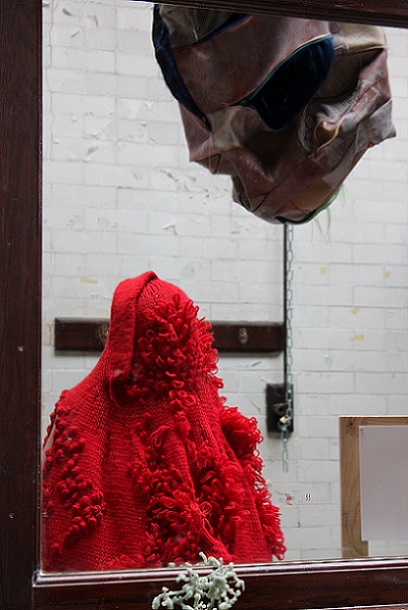For more performances, further images and information, please scroll down.
Feb 2018 and ongoing, I knit therefore I am

A montage of me knitting in public for World Wide Knit in Public Day, June 9th 2018
I find it hard to categorise I knit therefore I am, 2018. It isn’t a performance, yet it is performative; I do genuinely knit whenever and wherever I can. It is about knitting, but it isn’t about one soft sculpture. This is a sequel to I knit therefore I am, 2012, which is documented further down this page. Then, it was a project for University, led by me; this time, it's a series of images of me knitting in public, taken by my partner, Dave. Although the 2012 series is here, this time I’ve decided to categorise it as knitting, so for more details please visit my Knitting page.
1. Barafundle Bay, Pembrokeshire, 16.2.18
2. Overlooking Caldey Island, near Tenby, Pembrokeshire, 16.2.18
3. Saundersfoot, Pembrokeshire, 17.2.18
4. Worm's Head, Gower, with Lucy and Wolfie, 10.3.18
5. Bucks Mills, North Devon, 25.3.18
6. Rottingdean, West Sussex, 31.3.18
7. Worthing, West Sussex, 1.4.18
8. Priors Wood, Portbury, near Bristol, 5.5.18
9. Buckingham Palace garden party, 15.5.18
10. Volterra, Tuscany, Italy, 29.5.18
11. My I knit therefore I am montage for World Wide Knit in Public Day, 9.6.18
12. My Instagram post for WWKIPD, 9.6.18
13. Winner!
September 2016, Don't wash your dirty laundry in public at Synecdoche's Bodies residency at The Unit, Bristol
This participatory installation had some very distinctive performative elements to it. Have a look at my blog post, Free clothes, conversations and a washing line, for my reflections about that and also look at the documentation I made of the process, Don't wash your dirty laundry in public.
June 2016, Wearing the unwearable, Heart of darkness I at Privy at The Edwardian Cloakrooms, Bristol
May 2015, Wearing the unwearable, The Others; a self-portrait
'In its relationship with dress, the body is an eminently osmotic shell: when we adopt certain garments we do not confine ourselves to knowing their qualities and attributes, since, through direct physical contact we also assimilate them, we make them our flesh.’ (Cavallaro and Warwick,1998, in Simonson, 2008, p217, their italics)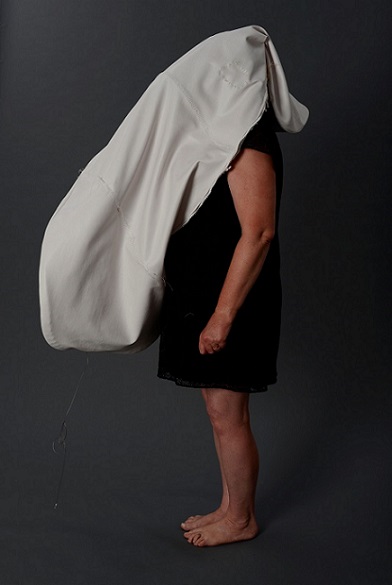
Other 1, Wearing the unwearable, 2015
For several years I have been exploring the body, more specifically, my body, through soft sculpture. In the process of making, I always have an irresistible desire the wear my work at various stages. I begin to see these episodes not only as ‘fittings’ but also as part of the embodiment; making them me. Some of these moments are captured with a camera, but as I normally work alone, more often they are not. With The Others, I decided to arrange a photo shoot in a studio, as this aspect of my work seems to be becoming more and more significant.
The links between garment and body are clear. The art theorist, Anne Hamlyn, refers to the clothing we wear as a ‘surrogate skin, a body at one remove’ (Hamlyn, 2000, p.42). From my teens to my thirties I delighted in designing and making all my own clothes. Although I must have been taught by my mother and grandmother, my inspiration came from my two older sisters and financial necessity. These skills also enabled me to express myself. It was very pleasing to wear clothing that nobody else wore, so I developed my own idiosyncratic style as I developed my identity. It has only been relatively recently that I have begun to realise that the garment making skills I have taken for granted for so many years transfer readily to a fine art setting.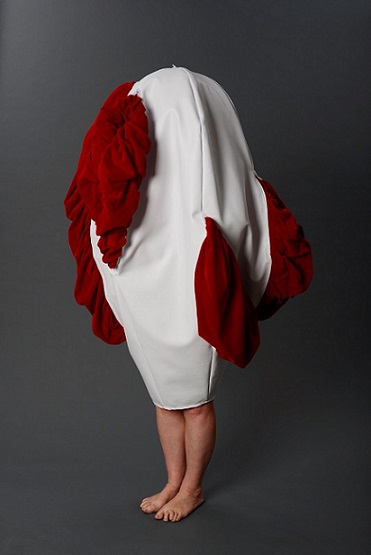
Other 2, Wearing the unwearable, 2015
For a while I have been recognising that these troubling, abstract forms are a form of self-portrait, so wearing them seems obvious. Although I had worn them at various points whilst making them, it felt very different, and quite thrilling, to wear them with an audience, albeit, an audience of 2 and in front of a camera! It was intriguing. I felt they became part of me; living, moving sculptures. I had found the perfect way to animate my work. My Frankenstein’s monsters.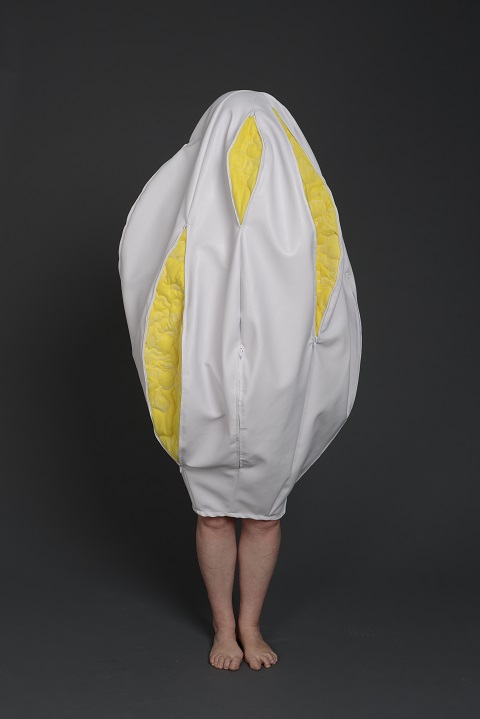
Other 3, Wearing the unwearable, 2015 I have exhibited this image as a framed A1 fine art print.
Although I am generally ambivalent about framing my work,
I think this works well and makes it accessible to more viewers.
I begin to see my sculptures as shrouds or body bags for different aspects of me, my multiple selves, which reveal and conceal elements of what lies within through the zipped openings. It is no coincidence that they are my size and shape. It is an idea I have visited in my work before. It explores the identity that nobody sees, and the idea that middle age brings invisibility. The inability to breathe, claustrophobia, loss of control and consequent rising panic when I was zipped into Others 2 & 3 also mirrors the change in control as my body begins to let me down.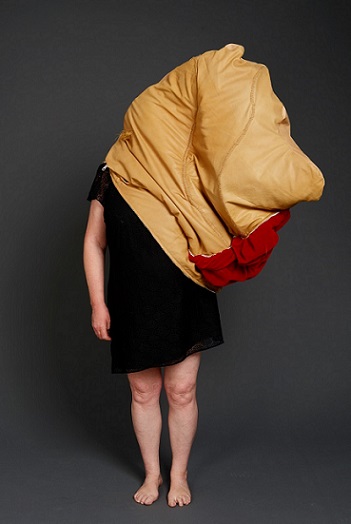
Other 4, Wearing the unwearable, 2015
By the time I did the photoshoot, all the sculptures were stuffed and finished so some of them were utterly unwearable. In practical terms, they would be impossible to wear independently! Deprived of air, sight and unable to move properly or remove them, I became totally dependent on my assistants. 
Other 5, Wearing the unwearable, 2015
I feel this series of images offer a very poignant take on identity, vulnerability and hiddenness. They is also something uncomfortably comical about them. Maybe it is the contrast of conflicting responses that makes them work so well? The shoot has totally changed my relationship with the work. It has made them much more intimate; now I see them from the inside as well as the outside.
Select bibliography
Cavallaro, D. and Warwick, A, 1998, Fashioning the Frame, Oxford: Berg in Simonson, Caryn, 2008, ‘Introduction’ in Textile, Volume 6, Issue 3, pp.216 – 221
Hamlyn, Anne, 2000, ‘Textures of Memory’, n.paradoxa 6 pp40-43 in Hemmings, Jessica, 2008, ‘Grown fashion: animal, vegetable or plastic’ in Textile, Volume 6, Issue 3, pp262 -27
2015, Wearing the unwearable, Nobody 3
I knitted Nobody 3 in 2014 but was interested to photograph it as part of my Wearing the unwearable series so I took it along to the photoshoot too. I love the flexibility of the knitted fabric, the way it drapes around me, but also moves with me. I think the very close associations with knitted garments makes it particularly poignant....but obviously I am still essentially hidden.
For more images and information please visit my Knitting page.
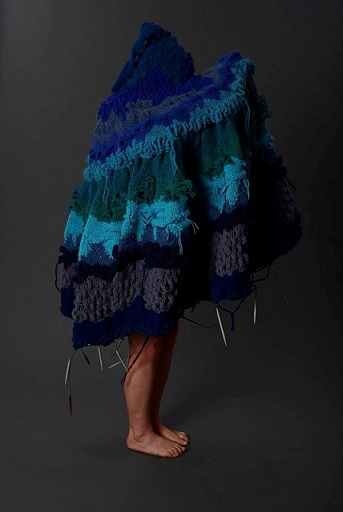
I have exhibited this image as a framed A1 fine art print.
Maybe it will mean that I won't actually have to perform live?


It had been worn before though….

Maura wearing my wave, Oct. 2013
Me wearing Nobody 3 al fresco
May 2012, Wearing the unwearable, Plastic surgery,
Cabot Circus, Bristol, 3rd May 2012, 4.30-5.30pm
Images courtesy of Jonny Baker
I am a reluctant performer, but I was challenged by my University tutor to wear Plastic Surgery whilst shopping in central Bristol. I spent an hour in one of Bristol’s busy shopping centres being photographed by Jonny as I shopped and walked around.
The public response:
I was surprised as I had very little response. Many people turned to stare or looked me up and down; some pointed and smiled or laughed but only one person made a comment and no one asked me why I was wearing a stuffed, multi-coloured garment sculpture!
Ladies toilet: The young woman cleaning and 4 or 5 other women looked at me as I put the sculpture on and quickly looked away. They then ignored me.
Cabot Circus security guard: As I came into the covered space outside the toilets a security guard looked at me and then kept looking back when I was on the escalator.
La Senza: I went in to look at the bras and a member of staff came over to me instantly. I told her I was doing an art project but she ignored that and started telling me how the underwear was arranged and told me which drawer to look in for XS briefs! I wish.
A group of young women looked me up and down, staring, with no smiles.
Topshop: The security guard went over to speak to another member of staff as soon as I walked in and pointed me out. They then watched me till I left.
Sainsbury Local: I bought a cereal bar and the young woman who served me made absolutely no response. She asked me if I wanted a bag and said ‘Have a nice day’ as I left.
Man on the Sky stand: I asked him for directions and he made no comment about my sculpture but politely suggested I ask at the Information desk.
Photo exhibition: I went into an art gallery to look at a photographic exhibition. There were two people in there who looked at me but then ignored me.
Outside Curves: A guy walked past, smiled at me, and said ‘Different!’
My response:
I was surprised at how much I enjoyed myself, overall. I was very self-conscious to begin with and found it hard to make eye contact or interact with the people around me. However, after a while, I began to forget what I was doing and settled into the rhythm of shopping. I found it very entertaining, seeing people watching me and then quickly looking away, but it was also very embarrassing. I didn’t see anyone I know, which was a relief at some levels.
I was also very relieved when I could finally take off the garment sculpture and be my normal self again. I was ridiculously pleased that I had done it.
Evaluation:
I think if I had been bolder or if I had been behaving in a more unusual way I would have had a better response. It was also quite quiet and I wonder if repeating the process on a Saturday afternoon, or elsewhere would have different results. Performing in other places might also get more response. I wondered about trying different areas of Bristol, my local High Street, a supermarket, a small village, a pub, a bus, Bower Ashton, a gym… the list is endless.
I could have set up some way of interviewing people or given out leaflets and asked for a response but I’m not sure I want to! I still feel very ambivalent about performance art generally and more specifically, about me performing.
If I had seen someone wearing what I was wearing I would have been intrigued but I too would probably have looked, smiled and turned away. I would have wanted to find out more, but would probably not have asked.
As city dwellers we are used to witnessing interventions and unusual happenings. We are conditioned to not respond or interact. My son, who works in Tesco, says that people doing unusual things often come in to the store and the staff are trained to ignore them, so they do!
Physical and conceptual changes:
Deciding to wear the sculpture has changed it, both physically and conceptually:
I knew that wearing it could damage it as the plastic is fragile in places but I liked the idea of performance creating change. I decided to alter it slightly by stitching the shoulder seams and one side seam. I then added some Velcro to the other side seam. It has made it more wearable and has only subtly altered the aesthetics. It now no longer needs the pins to hold it together so it has lost one subtlety but has gained a trace of the memory of being worn in the torn plastic at the neck.
Wearing the sculpture in public has also changed it conceptually. It is now truly a wearable, and worn, sculpture. It is highly appropriate that it has been worn by me as it is a self-portrait. It interests me that I found the experience liberating and also that I had almost no response. Does it speak of tolerance, immunity or apathy on the part of the onlookers?
Showing a slideshow of the performative research alongside the sculpture adds a new dimension to the piece. It becomes more truly a self-portrait. Wearing it in a shopping centre adds poignancy to the original concept of identity, self-image and body size.
It also felt very much as if I was making myself vulnerable, exposing my inner self to the outside. The concentric patterning also seem more obviously like targets, demanding attention. The bright colours mirror the colours of the merchandise in the shops; the contours contrast with the promotional material and displays of the ‘ideal woman’.
My ambition was to make a whole body but I am happy with the torso as I have come to realise how body parts can represent the whole. It was only when I wore it, however, that I realised that as part of my body, it became a whole body.
More changes, November 2015:
Over the intervening years in storage, some of the plastic has begun to deteriorate, crumbling and disintegrating to nothing. I feel this adds to the piece, as it emphasises the bodily resonance, highlighting a sense of aging and fragility. It will be interesting to see what has become of it the next time I decide to exhibit it.
It also raises issues of the conservation of unconventional materials in art. I know that Eva
Hesse’s work with plastic has also deteriorated. Personally I feel that choosing to use
impermanent materials in sculpture brings to mind our mortality. In this piece, it feels highly appropriate that the obsession with the so called ‘ideal’ female form over time crumbles to nothing.
Knit. Think. Think. Knit. Knitting is part of my identity. I knit whenever and wherever I can. I decided to try to capture the private and public aspects of my knitting practice over a period of a month through a series of performance stills.
When I am alone, the process of knitting allows me to lose myself in my work so that I quickly enter a state of altered consciousness, a trance-like timelessness. This induces a profound sense of well-being. The meditative, repetitive movement enables deep thinking and I often have ‘eureka’ moments whilst knitting.
Janine Antoni in ‘Slumber’ recorded her brainwaves as she slept and wove their pattern by day into a blanket to cover her at night. The continuity between process in consciousness and process in unconsciousness intrigues me.
I have been knitting with some unusual materials. Fishing line, for example, when knitted on large needles, emerges as a sparkling ethereal web which reveals and conceals parts of itself as the environment changes. There is, however, a demanding change in control as the plastic takes on a life of its own but as the line is transformed into a three dimensional drawing through the process of knitting, there is a deep sense of satisfaction.
It appeals to me that knitting sculpts by addition rather than subtraction. I have found that some linear materials sustain a sculptural form purely through the manipulation of knitted stitches and skilled construction.
Knitting with plastic on large circular needles in public was particularly interesting. In a way, I think it was less instantly recognisable as knitting for the onlooker, but it was definitely a curiosity hook. I came to see the sculpture I was knitting as a form of net, capturing the comments and conversations around me, and somehow becoming part of the piece. It also taps into the long tradition of knitted nets. Having a different level of concentration in public, inevitably means that the form was influenced by what was happening around me. A working title for the sculpture emerged – Social network.
The most interesting outcome of this piece for me was how hard I found it to regard knitting as work, as I normally associate it with leisure and pleasure. Knitting with plastic was difficult, as the unruly material required levels of concentration that wool does not. It definitely made me more reluctant to knit and it was harder to enter the state of flow. Although I was delighted with the outcomes of knitted plastics, I haven’t used them since. I realise there is much more to explore with these materials.



